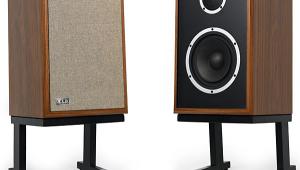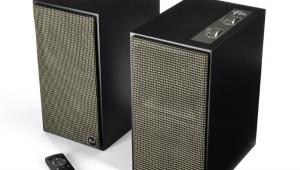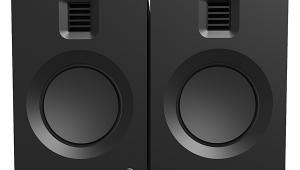Cambridge Audio Minx S215 Speaker System Page 2
The cube is made of damped thermopolymer, a fairly hard and scratch-resistant plastic, with a 0.75-inch extruded-aluminum band that acts as the baffle. On the back are some tough little metal binding posts whose interior holes are too small for banana plugs or 12-gauge cable but large enough for higher-gauge (thinner) zip cord or pin plugs. Mounting options include the 400M pivoting wall bracket ($25/pair); 600P adjustable floor stand ($120/pair), whose curved lacquered steel column rises from a bonded tempered-glass base; and the 600D table stand ($18/each), available in a single finish—gray brushed aluminum—which stands in contrast to the black or white cubes.

The X200 subwoofer measures less than 9 inches in all dimensions, about as tall as a kitten. Its three 6.5-inch cones include an active front-firing driver and two side-mounted passive radiators propelled by a 200-watt RMS amp. The use of passive radiators in lieu of a port eliminates chuffing (noise caused by moving-air turbulence). The single-piece aluminum diaphragms don’t have phase plugs or dust-cap cutouts, which enables them to be more rigid. Digital signal processing further controls the bass response.
All of this adds up to a recipe for a very controlled sub. On the back panel are the usual controls and a multi-pin port for a wireless adapter, about which little was known at press time.
Associated equipment included a Rotel RSX-1550 A/V receiver and OPPO BDP-83SE universal disc player. All movie demos were Blu-ray Discs. I kept the sub near the center-channel speaker for optimum dovetailing at the crossover.
Learning to Trust the Sub
Job one was dialing in the sub, which plays a greater role in a compact satellite/subwoofer set (cubed or otherwise) because it has to cover a wider range of frequencies. With larger standmount speakers, I’d cross over to the sub at 80 Hz. With an average sat/sub set, the minimum number would be 100 Hz, and I usually end up at 120 Hz. However, these small cubes are among the smallest satellites I’ve ever used. In fact, outlines of the single and dual cubes are stenciled right onto the sub’s crossover dial, at 140 Hz and 130 Hz, respectively. After some initial fooling around, I opted for 150 Hz but set it in my AVR. Initially, I raised the output level in the AVR several decibels over the normal setting and set the sub volume at the 50-percent mark. But as I came to trust the sub more, and craved additional bass, I upped it more and more. By the time my music demos began, the sub was operating near the top of its volume control’s range and still sounded tight.
The Order, in DTS-HD Master Audio, is a 2003 hocus-pocus vehicle with the always compelling Heath Ledger as a priest grappling with an ageless creature who sucks the sin out of people’s souls in scenes laden with visual and surround effects. Preposterous dialogue—“I am the conductor of the night train. The answer to your question is infinite.”—came across crystal clear. To find the right balance between dialogue and effects, I only had to engage in a bare minimum of volume fiddling, except in the loudest scenes, in which I did back off a bit. Male voices were on the light side, as was the putatively thunderous collapse of a domed building.
But in this initial demo, the sub volume wasn’t nearly as high as it would be later. In this and all of my subsequent demos—movies and music—the system’s on- and off-axis response were impressively consistent as I moved about the room. They were as good as I’ve ever heard from any type of speaker at any price.




























































